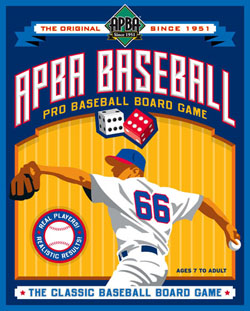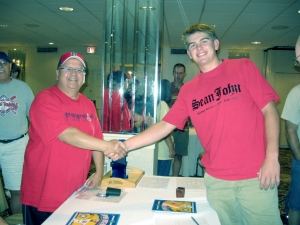How Would You Like to Manage in the Majors?: Baseball Board Games and Their Dedicated Players
This article was written by Tim Ponisciak
This article was published in Fall 2011 Baseball Research Journal
What if? This is one of the most often asked questions of historians. What if the Mayflower had not sailed? What if Robert Kennedy had not been assassinated? What if the Watergate break-in had never been discovered?
Baseball fans play out the same scenarios. What if Shoeless Joe Jackson had not been banned from baseball? What if the Phillies never traded Ryne Sandberg? What if Ken Griffey Jr. had not had so many injuries? What if the 1998 Yankees could have played against the 1927 Yankees?
 In baseball, dedicated fans are lucky enough to have some idea of how these situations would have played out. A generation of fans has enjoyed countless hours playing out these scenarios, and others, thanks to a few dedicated people who had a love for statistics and a dedication to accuracy.
In baseball, dedicated fans are lucky enough to have some idea of how these situations would have played out. A generation of fans has enjoyed countless hours playing out these scenarios, and others, thanks to a few dedicated people who had a love for statistics and a dedication to accuracy.
Board games have long been a part of American culture. Parker Brothers and Milton Bradley helped to popularize many board games like Monopoly, Risk, The Game of Life, and Clue throughout the first half of the twentieth century. Board games were often looked to as a way to relax, a way to entertain, and a way to escape. Even in a bad economy, board games often thrive as an affordable way to have fun. Naturally, with the board game industry growing at the same time as the national pastime, there was a market for baseball board games. Journalist Jonathan Tully wrote, “According to the Baseball Hall of Fame, in-home amusements based on baseball stretch back as far as 1866, when ‘fashionable people in New York City were playing Parlour Baseball.’”1
There were a number of baseball-themed board games that arrived on the market throughout baseball’s early years, but not many actually tried to simulate the real action of a game. The first baseball simulation board game that gained popularity was National Pastime, a predecessor to APBA (American Professional Baseball Association). National Pastime was the first game to use player statistics to determine game play. However, the first game to really catch on with baseball enthusiasts was the Ethan Allen All-Star Baseball game, first distributed in 1941. Allen, a former ballplayer, created a game where probabilities for certain batting outcomes, based on a player’s statistics, were represented on a disk. If a player was a power hitter, the home run area on the disk would be larger than the singles area. Players would spin a dial which would land on one of the outcomes on the disk. The game had success, but was limited in its ability to replicate actual strategy and statistics (a pitcher’s ability did not play a role in this game). It was geared toward children, and as a result, many players lost interest once they reached their adult years. Cadaco is the most recent producer of All-Star Baseball, having last produced the game in 2004, and while the game has remained popular, it does not have the same cult following that other games have enjoyed.
In 1951 a new game came on the market that targeted older baseball fans. APBA is a game created by Dick Seitz. APBA combined the use of dice with player cards that represented a player’s statistics. The game included both hitting and pitching aspects. Seitz’s first production run was in 1951 and the game caught on. Fans enjoyed being able to replicate the excitement of watching Major League Baseball through playing a board game. Now fans had a way to pass the time during the long winter months when there was no big league baseball to enjoy. Seitz continued to refine his game over the next few years and APBA began to gain popularity.
At around the same time, a young man named Hal Richman was also tinkering with his own baseball strategy game. Mr. Richman had been fine tuning his own game for a few years, and when APBA was released, Mr. Richman was upset as he felt someone beat him to the punch. However, he continued to work on his own game, and Strat-O-Matic was released in 1961. Strat-O-Matic was not successful initially, but in its third year, Mr. Richman took out a loan from his father with the understanding that if he did not make his game a success, he would go into his father’s insurance business. Thankfully for him and the many future adherents of the game, Strat-O-Matic quickly became profitable.
 Through the years, many possible competitors have appeared, including Pursue the Pennant, Replay, and Statis Pro Baseball, but only a few have become
Through the years, many possible competitors have appeared, including Pursue the Pennant, Replay, and Statis Pro Baseball, but only a few have become
sustainable players in the market. The arrival of videogames has caused the market for baseball strategy board games to shrink to the point that the current market can support only a few of the games. APBA and Strat-O-Matic have remained. Most impressive is that both of these games have managed to garner
the majority of their new players through mail-order marketing campaigns and magazine ads, rather than relying on in-store sales.
WHAT HAS ALLOWED THESE GAMES TO STAY POPULAR?
John Herson, owner of APBA, says one big reason APBA has remained popular is that it has stayed true to its roots. Not many changes have been made over the years to the rules or gameplay, so players have gained a certain level of familiarity and comfort with the game. In a game of APBA, players roll two dice, and the numbers on the dice are read in sequence. Each player has a card with every possible dice combination shown (3 and 4, 2 and 1, 6 and 6), which corresponds to a new number. Players then consult a chart to determine what the result of the at-bat is, with different charts depending on how many runners are on base, and different results depending on the talent of the pitcher. The only major change has been the addition of the advanced version of gameplay.
Herson believes that APBA has endured because it is a game that tends to get passed down from father to son. While many children will stop playing the game when they reach high school and college, many young men come back to the game once they are older, because of the bond it provides to childhood.
Like APBA, Strat-O-Matic also has not made any significant changes to its game since it was first released. Strat-O-Matic also uses dice and player cards to simulate the action of a game, but includes most at-bat information on the hitter and pitcher cards. Richman has created advanced versions of Strat-O-Matic that feature ratings for hit and run ability, outfielders’ throwing arms, and pitchers’ endurance.2
In recent years, both APBA and Strat-O-Matic have come out with computerized versions of their games, but both Herson and Richman believe that there will always be a place for the board game versions. Richman believes there is “something about having the dice in your hands. It gives you a sense of control.” Herson also believes there will always be a board game version of APBA because it is an escape from real life. People stare at their computers all day, and want a chance to focus on something else when they relax.
THE APBA AND STRAT-O-MATIC FANATICS
 Almost every childhood baseball fan has the dream of playing baseball in the majors as an adult. We dream of one day shagging flies for the Phillies or hitting the game-winning, three-run homer for the White Sox. For the large majority, this dream will not come true. Only the slightest percentage of us has the talent to even make it to the college level. However, games like Strat-O-Matic and APBA allow players to feel like they are running a club. These games allow players to see what strategies they would use in real game situations.
Almost every childhood baseball fan has the dream of playing baseball in the majors as an adult. We dream of one day shagging flies for the Phillies or hitting the game-winning, three-run homer for the White Sox. For the large majority, this dream will not come true. Only the slightest percentage of us has the talent to even make it to the college level. However, games like Strat-O-Matic and APBA allow players to feel like they are running a club. These games allow players to see what strategies they would use in real game situations.
Much like games such as Monopoly, poker, and Settlers of Catan, APBA and Strat-O-Matic do have their casual players, but there are an inordinate number of baseball fans who play these games weekly or daily. Many fans play simulations of entire seasons, create dream teams, or participate in organized leagues with drafts and daily box scores. “For years, Hollis McLoughlin has managed an APBA dream squad,” Mary Alice Kellogg wrote in the article “Dice Baseball Fever” from Newsweek. “McLoughlin would write fictitious press releases and news reports about the team. In the off-season… he would write the front offices of the real-life teams that held the contract of the player he wanted to trade and ask them if, hypothetically, they would make the move he was considering. Most teams responded, and he abided by their decision.”3 Some passionate players are even willing to travel miles and miles just to make sure they have the newest season’s cards to use for the game. In Bryan Johnson’s article “Pull up a chair and play ball,” he writes, “One devotee actually flew in from Houston to pick up four editions of Strat-O-Matic’s latest player cards, then made stopovers in Pennsylvania and Michigan to deliver them to friends… Such treks are equally common in Lancaster, PA, a Mecca for thousands of others whose table-top obsession is centered on APBA Baseball, the 34-year-old granddaddy of sports simulation games, and Strat-O-Matic’s main competitor.”4
What brings people to roll the dice day in and day out? Michael Jaffe, a Strat-O-Matic player for over 40 years, does a good job of summing it up: “I enjoy each decision that has to be made and the thought process involved with the situation at hand… I enjoy seeing what the outcome will be if I try something novel as opposed to playing by the book.” The ability to play out what-if scenarios, as well as to replay past seasons is a big drawing card for these games. Peter Winske, an APBA player for 50 years, believes, “The game combines an acceptable level of realism with the ability to play the game in a reasonable amount of time.” One longtime APBA player stated, “I like to see what happens with teams when I use my managing techniques” and mentioned that he will be playing 36 seasons of APBA baseball solitary once he retires. Many players also mentioned nostalgic reasons for playing. Gary Block, a long time APBA player, notes that he enjoys “being able to relive the time from my youth through the players from that era.”
THE DIFFERENCE BETWEEN STRAT AND APBA
APBA and Strat-O-Matic, while different, both attempt to capture the same niche market. However, while there are some baseball fans who play both, most game players will choose one and stick with it. Some differences stand out to the avid players. A commonly held opinion of Strat-O-Matic fanatics is stated by Michael Jaffe: “Strat-O-Matic has greater depth, requiring more decision making… The challenge and enjoyment I derive from playing these games comes from the decisions that I have to make as manager.” The main case for APBA seems to be the ease of play. Brett Weeks, an APBA player of 27 years, loves “how easy it is to know the outcomes of certain dice rolls.” In APBA, a roll of 6 and 6 is almost certainly a good result for the hitter, and many times results in a home run. Fifty-year APBA player Phil Grabar also noted, “APBA is fast and easy to play, yields accurate stats, and its player cards have the most personality in the business.”
However, the same motivations draw both sets of players to their respective games. Both groups love the camaraderie they get from playing the game with either long-time friends or new friends from across the country. The feeling of control is also a strong motivator. Pete Mitchell, a player of both Strat-O-Matic and APBA, likes “the feel that you truly ‘own’ or control the players. It is different than fantasy [baseball].” Peter Winske says of APBA that “the game has allowed me to make friends throughout the country.” Both the APBA and Strat-O-Matic companies provide opportunities for new friendships to be created through their respective games by hosting annual conventions. APBA hosts a convention each July, and recently had over 100 players come to Lancaster for the event. Strat-O-Matic recently held a celebration of its fiftieth anniversary in Manhattan. At this event, Brent Carow, a long-time Strat player, was named the game’s ultimate fan.
Carow sums up his feelings for the game very well: “I don’t think there is a single thing that could have kept my group of friends together more than Strat-O-Matic. My friends are an engineer, a grocery store manager, a coin salesman, an accountant, and a guy who builds computers for the government. Half of us have kids, half of us have wives… We play games via Skype, via phone, and of course in person. Baseball has a special bond because people experience the game and remember the players as a shared moment in time. Such is Strat-O-Matic… It’s fun to manage against other individuals whether it is once every 20 years or 20 times every year.”
The rivalry between APBA and Strat-O-Matic has never been a bitter one. Many players will switch from one game to another every few years based on their own preferences or on the preferences of their friends. Greg Wells, a longtime APBA player, says “When I meet a Strat player I know I can talk to them about what they do with the game and I never consider that APBA is better. The ability to recreate the game, in my mind, is the most important thing.”
WHAT DOES THE FUTURE HOLD?
While both Strat-O-Matic and APBA have dedicated, loyal followings, their fan bases skew older. As a result, there is concern regarding the future for the board game versions of these games. Each game benefits from being passed down by generation, but will continue to compete with video games, the Internet, and cell phones. With the advent of the online versions of these strategy games, each should hopefully continue to thrive and make new players out of fans of the
national pastime.
The popularity of baseball will ultimately play the biggest role in the future popularity of Strat-O-Matic and APBA. As Brett Carow states, “For me this sport has become a way of life. The baseball stars I was attached to as a child come to life on a Strat-O-Matic baseball card.” As long as adults are looking for a way to connect with the passion for baseball they had as children, Strat-O-Matic and APBA will continue to thrive.
TIM PONISCIAK has been a SABR member since 2008. Tim lives in Granger, Indiana, with his wife and dog. If you’re interested in more of Tim’s research on baseball board games, e-mail tponisci@gmail.com.
Notes
1 Jonathan Tully, “Tabletop Dynasty,” Palm Beach Post,15 July 2006.
2 Stuart Miller, “Strat-O-Matic devotees celebrate its 50th Anniver- sary,” New York Times, 13 February 2011.
3 Mary Alice Kellogg with Christopher Ma, “Dice Baseball Fever,” Newsweek, 23 August 1976.
4 Bryan Johnson, “Pull up a chair and play ball,” The Globe and Mail, 9 June 1984.


